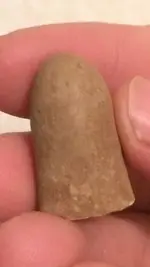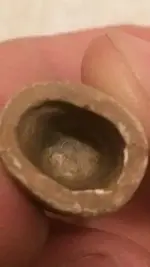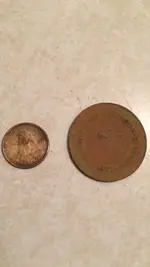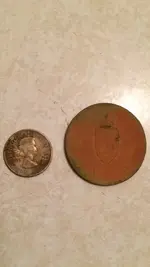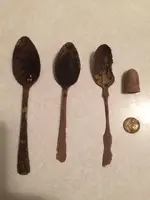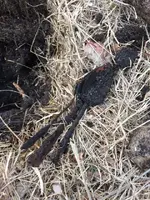Basically the experts don't know what all the numbers & letters mean in the base. Here is a detailed reply from one of the US Leading Experts;
''The smooth sided Pritchett bullets are often encountered with numbers or letters in the base cavities. Sometimes, there is both a number and a letter such as L2; other bullets have various letters and some have star or asterisk designs. Some bullets have been recovered in America with US or CS stampings in the base cavities (there is some skepticism as to if the markings are original to the Civil War period). Bullets are found with the letter P, with interlocking P's, with q, with variants to include P., q., etc. There are at least 35 different base cavity markings known. The L markings include L, L . , L1, L2, etc up to L 12. Numbers such as 55 or 57 indicate the calibre of the bullet (not necessarily accurate designations).
There are several theories regarding the markings, but I am not positive that there is any period documentation to confirm any of the theories. Over 100 smooth-sided Pritchett bullets were recovered from the wreck of the blockade runner Modern Greece in 1962. Those bullets have several different cavity stamps. The bullets also varied in cavity depth, bullet diameters, and overall weight. Unfortunately, the team that processed the recovered bullets did not correlate cavity markings to the dimensions and weights.
Some collectors state that the base markings designate either the site of manufacture or the contractor or company that made the bullets. "L" supposedly signifies London, but would more likely indicate Ludlow, one of the large suppliers of ammunition. The other letter stampings allegedly are those of ammunition makers; however, the letter do not seem to correspond with the names of known makers. Another problem is that few ammunition collectors seem to know very much about the manufacturing process, and one of the primary reference works states that the Pritchett bullets were cast. In actual practice, most of the bullets were swaged. It would be extremely difficult to extract the bullet from the mould if the base plug had raised letters on it.
When the bullets were swaged, the base punch/ram that compressed the bullet also had the letter, number, or design marking on the end of the punch. That marking was pressed into the bullet. I believe that the markings on the punches were to designate specific machines, machine operators, or lots (by date of manufacture or by bullet size or cavity style). When a swage die became worn or a different contract was taken, a "dot" or number could be added to signify the change. The same base punch could thus be used again to identify a subsequent lot of projectiles.
Most shooters purchased their bullets. That was true of the casual shooter as well as the serious marksman. It was easier to purchase swaged bullets than it was to cast up bullets using the all-brass moulds that were generally supplied with rifles. A particular weight or base cavity type might have had a following - "I'd like 100 of the L2 bullets, please." "Do you have any of the heavy 25 bore bullets with the four dot cavity markings?"
The government bullets frequently had Broad Arrows around the rim of the bases, and some had WD markings interspersed with Broad Arrows. The British Army also issued a "rectifying machine," which was actually a press-sizer, to outposts that might run out of swaged ammunition and be forced to cast up ammunition locally. The sizer punches may have had identifying numbers. ''
